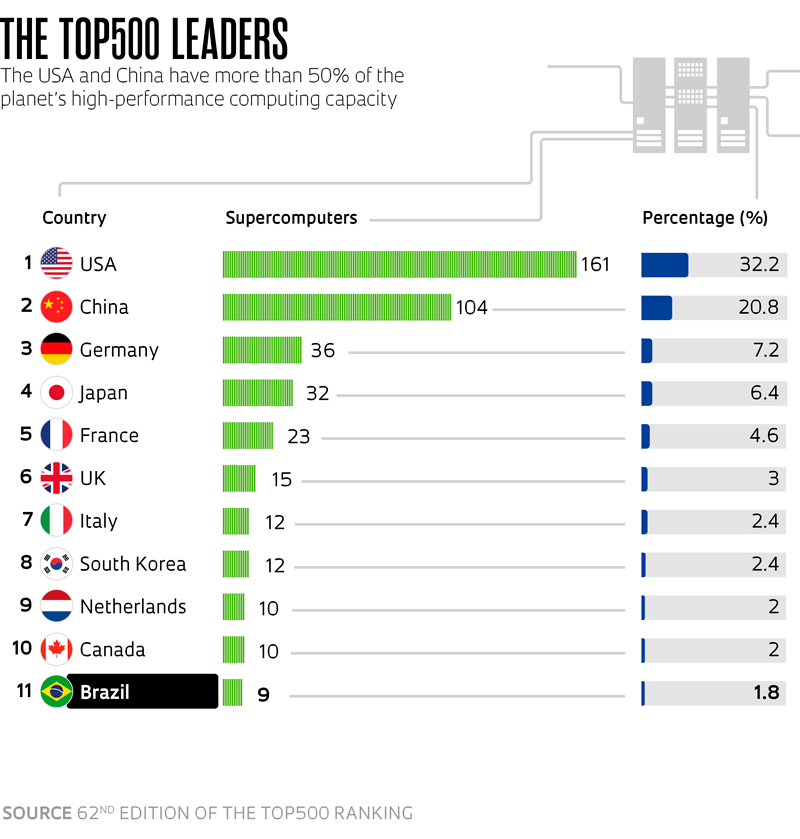Cover
With the power to perform 1 quintillion mathematical operations per second, Frontier has set a new standard in data processing
Frontier, built by American company Hewlett Packard Enterprise (HPE), was the world’s first exascale supercomputer. One exaflop represents the ability to perform 1 quintillion floating-point operations per second. The computing power of an exascale machine is equivalent to 5.7 million laptops.
Based at the Oak Ridge National Laboratory in Tennessee, a research institution managed by the US Department of Energy (DOE), Frontier began operating with a capacity of 1.102 exaflops in May 2022, before being upgraded to 1.194 exaflops at the end of the same year. The machine easily topped the 62nd edition of the TOP500 list of the most powerful supercomputers in the world, published in November 2023.
The runner-up, also based in the USA, was the Intel/HPE Aurora, which belongs to the Argonne National Laboratory in Lemont, managed by the University of Chicago. With 585.3 petaflops, Aurora was designed with a potential total capacity of 2 exaflops, which would make it the most powerful supercomputer in the world. The machine is also part of the DOE’s research infrastructure.
The top five is completed by Nvidia’s 561.2-petaflop Eagle supercomputer, used by Microsoft’s Azure cloud computing platform; Fujitsu’s 442-petaflop Fugaku, built for the RIKEN Center for Computational Science (R-CCS) in Kobe, Japan; and HPE’s 379-petaflop LUMI, installed at the data center of Finnish state-owned company CSC in Kajaani, Finland.
The supercomputers below 15th position have less than 50 petaflops, reflecting the gulf between the newer machines with exaflop capacities and the majority of the high-performance computing (HPC) infrastructure around the world.
The project under development with the greatest computational capacity is the Condor Galaxy, which will consist of a network of nine interconnected supercomputers with a total processing power of 36 exaflops. It is the result of a partnership between American company Cerebras Systems and the United Arab Emirates’s G42, both of which operate in the AI sector.
Although no official costs have been released, American media estimates that building an exascale supercomputer requires investment of roughly US$500 million. The USA, Japan, and South Korea are among the world’s leading manufacturers of supercomputers. With no established cutting-edge computer industry, Brazil has little presence in the field.
Nvidia and self-driving vehicle maker Tesla have also announced plans to build exascale supercomputers. Nvidia’s DGX GH 200 will be used to develop generative AI solutions. It is already undergoing testing and should be ready to begin commercial operations later this year, when its real computing power will be known. Tesla’s new supercomputer will be used to train the company’s autonomous driving systems. The company has not shared a timeframe for its completion.
Eco-efficiency
The organizers of the TOP500 ranking also publish another list, the Green500, which ranks the supercomputers that combine high computational power with energy efficiency to become the most eco-efficient in the world.
The list is topped by Henry, based at the Flatiron Institute in New York and used to advance scientific research through computational methods. The supercomputer has an energy efficiency rating of 65.40 gigaflops per watt (Gflops/w) — a measure that reflects the capacity to perform operations quickly with minimal energy expenditure. In second place was Frontier Test & Development — a particular rack of Frontier — with 62.68 Gflops/w.
The six Petrobras computers listed in the TOP500 are all among the 100 most eco-efficient in the world. Pégaso was the highest placed, in 46th position with an energy efficiency of 18.46 Gflops/w.
Projects
1. CECC – Center for Research in Engineering and Computational Sciences (nº 13/08293-7); Grant Mechanism Research, Innovation, and Dissemination Centers (RIDCs); Principal Investigator Munir Salomão Skaf (UNICAMP); Investment R$38,701,865.93.
2. High-fidelity numerical simulations applied to unsteady aerodynamics, turbulence, and aeroacoustics (nº 21/06448-0); Grant Mechanism Young Investigator Award; Principal Investigator William Roberto Wolf (UNICAMP); Investment R$2,274,026.90.
Republish
